1900
Born Dezember 28th , as child of the carpenter Wilhelm Lachnit and his
wife Emma Martha Lachnit in Gittersee, a suburb of Dresden.
Max had five siblings: the elder sisters Elisabeth and Helene, the brother
Wilhelm (1899-1962),
and the jounger siblings Rudolf and Charlotte.
1915-19
Apprenticeship as carpenter with specialization in the reproduction of furniture from the Rococo period in Dresden.
1919-25
Worked as a cabinet-maker, further education at the night school of the Dresdner Kunstgewerbeschule (arts and craft school), meets Eugen Hoffmann, Otto Griebel, Eric Johansson, Otto Dix and Hans Grundig. First independent furniture designs.
1925-27
Studies at the Academy of Arts and Crafts in interior design (Professor: Erich Ziesche). He designs furnitures which are manufactured in the cabinetmaker's workshop Wörner in Hellerau..
1928-31
A small workshop in his parent's house in Dresden becomes his first studio.He designs more furniture for the cabinetmaker in Hellerau and several architectural blueprints. Lachnit gets unemployed. the cooperation with his friend Eugen Hoffmann (1892-1955) at a model for the "Simon-Bolivar-Monument " in Quito, Peru, initiates his interest in sculpturest.
1931
Wedding with Helene Margarethe Klara Tischer.
1932-35
Birth of the daughter Christine. Member of the German Association of Architects (BDA), works as an architect. studies the philosophical work Hosserl, Nietzsche and others, interest in Eastern Asian phiolosophy and history. The second daughter Marie Louise (*1935) dies at the age of four weeks.
1936-39
Works with the architect Herrmann Richter (1894-1942) in Dresden. Submits blueprint for the planned rebuilding of the Semperoper in Dresden. Creates reliefs and ornamental sculptures for buildings of the architect Wilhelm Kreis..
1939-45
Shows several sculptures at the Hygiene-Exhibition in Dresden.
1945
Looses his studio and all his works during the bombing of Dresden at February 13th.
1946-50
Moves into his new studio in the house of artists in Loschwitz, Dresden. New start with the cycle "Kulturaufbau" (rebuilding of culture). Designs a model for the rebuilding of Dresden. Creates the terracotta sculptures "Life and Death", "Three Women with Dove" and the small group sculpture "Meeting". Participation at the an der 1. Exhibition of Artists of Dresden in October 1947 with the bronze sculpture "Girl with Scarf". He shows the plaster sculpture "Two Young Man" at the 2. Exhibition in 1949.
1950-51
First paintings "Circus ", "The Song" und a self-portrait. At the 3. Exhibition of Artists of Dresden 1951 he shows the relief "Rebuilding".
1951-53
Several designs for reliefs and ornamental sculptures for the rebuilding of Dresden. Sculptures "Reading Couple", "Acrobats", " Genius", "The Small Auschwitz group" und die "Threat".
1954-56
In cooperation with Prof. Wolfgang Rauda design of several reliefs and ornamental sculptures at the exterior of the student hostel Gargarinstraße in Dresden, reliefs at the Old Market, relief at the archway of the former department store at the Old Market; at the exterior of the instute for thermodynamics. He shows the sculptures "Dancers" and "Performer I and II" at the 1. Exhibition of the District Dresden of the VbK Germany. Participates in exhibitions in Stuttgart, Düsseldorf and Frankfurt/Main. Model of the fountain "Der Flugwille des Menschen" for Güntzstraße in Dresden.
1957
5. Pize at the "International Competition" for the rebuilding of the place in front of the former Legue of Nations in Geneve (together with Prof. Rauda).
1958-61
Shows the etchings "Rider ", "Conversation"; and "Birth and Death" on the Great Exhibition in Berlin. Participation at the "International Competition" for the "Memorial Auschwitz". 1. Price in the competition for the decoration of the stairwell of the canteen of the Verkehrshochschule Dresden (Realization in 1960). Relief "Verklärung Christi"of the altar wall of the catholic church in Dresden-Strehlen.
1962
Moves in the studio of his brother Wilhelm Lachnit who died November 14th.
1962-68
Creates mainly abstract sculptures, pastells and graphics.
1968
1. Personal exhibition in the Leonhardi-Museum in Dresden.
1968-72
Creates mainly monotypes from etched and colored zinc sheets. His work gets often interrupted by illness.
1972
Max Lachnit dies on November 1st in Dresden.
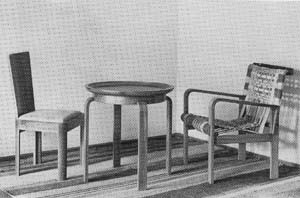
Furniture designed by Max Lachnit l (~1930)
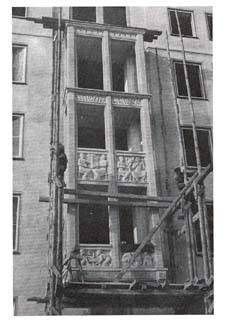
Relief decoration at the student hostel Gargarinstraße, Dresden, 1954
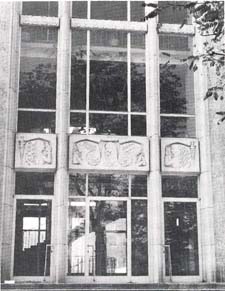
Relief decoration at the Institute forr Thermodynamics, 1955
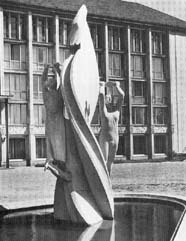
Fountain "Der Flugwille des Menschen", ~1956
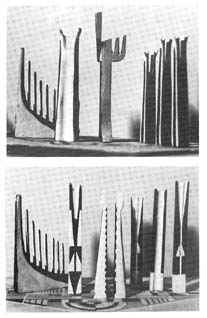
Models for the Memorial Ausschwitz, 1958
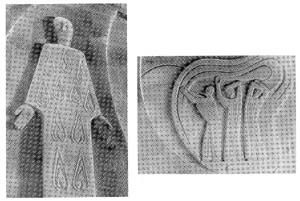
Details of the altar relief "Verklärung Christi", 1961